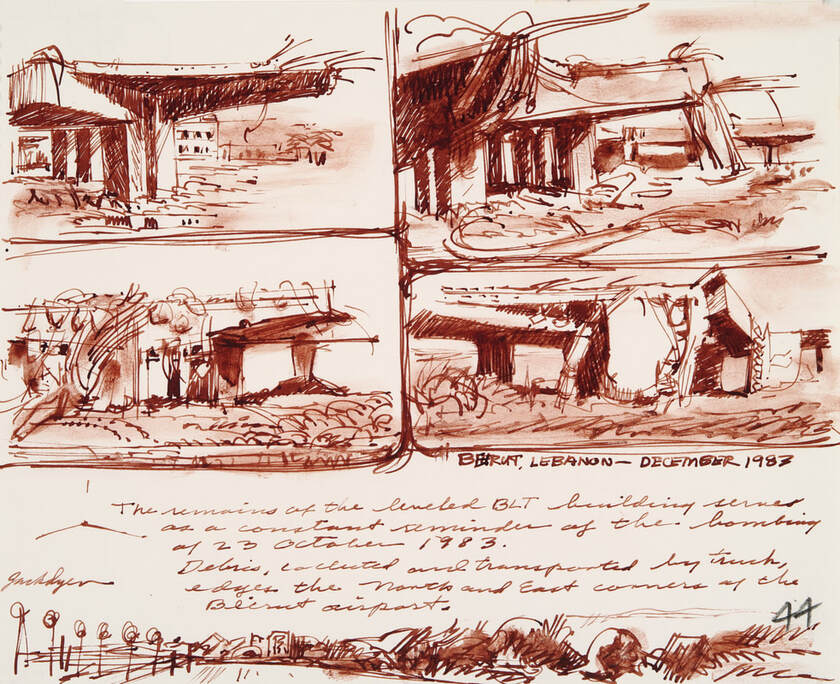by Joan Thomas, Art Curator
After the tragic deaths of 220 Marines and 21 US service personnel on 23 October 1983 at the Battalion Landing Team Headquarters, in Beirut, Lebanon, the decision was made by the Marine Corps to send a combat artist to document the event and aftermath.
Major John T. “Jack” Dyer, USMCR (Ret.) was the curator for the Marine Corps’ art collection and had served as a combat artist during Vietnam. Following the terrorist attack, he was recalled to active duty, and within several weeks he received his orders to Lebanon. Dyer departed in December 1983 and remained in country for the next several weeks, creating on-the-spot drawings, sketches and watercolors of what he was seeing on the ground. Upon his return to the States, he resumed his retired status and once again took up his position as curator of art for the Marine Corps’ Museum and History Division (the predecessor to the National Museum of the Marine Corps). During his time in Beirut, Dyer created over ninety-five works, and later continued to use his sketches and drawings to create finished studio works in watercolor.
For many of his pieces, Dyer preferred sepia brown toned ink in his drawings and sketches. The ink also served as the underdrawings for several of his later finished watercolors. The ink could also be combined with liquid to make a wash of brown toned color. Below is a small sampling of the drawings and watercolors the artist completed or composed while in Beirut.
After the tragic deaths of 220 Marines and 21 US service personnel on 23 October 1983 at the Battalion Landing Team Headquarters, in Beirut, Lebanon, the decision was made by the Marine Corps to send a combat artist to document the event and aftermath.
Major John T. “Jack” Dyer, USMCR (Ret.) was the curator for the Marine Corps’ art collection and had served as a combat artist during Vietnam. Following the terrorist attack, he was recalled to active duty, and within several weeks he received his orders to Lebanon. Dyer departed in December 1983 and remained in country for the next several weeks, creating on-the-spot drawings, sketches and watercolors of what he was seeing on the ground. Upon his return to the States, he resumed his retired status and once again took up his position as curator of art for the Marine Corps’ Museum and History Division (the predecessor to the National Museum of the Marine Corps). During his time in Beirut, Dyer created over ninety-five works, and later continued to use his sketches and drawings to create finished studio works in watercolor.
For many of his pieces, Dyer preferred sepia brown toned ink in his drawings and sketches. The ink also served as the underdrawings for several of his later finished watercolors. The ink could also be combined with liquid to make a wash of brown toned color. Below is a small sampling of the drawings and watercolors the artist completed or composed while in Beirut.
"Hotel" Battery, 3/10 BLT, 2/8, Beirut by Major John T. Dyer, Jr., USMCR (Ret)
Pen and ink, wash on offset printing blotter paper
Accession number: 2012.1001.318
The remains of BLT HQ building in Beirut, Lebanon, which was destroyed by terrorist bombing on 23 October 1983.
Pen and ink, wash on offset printing blotter paper
Accession number: 2012.1001.318
The remains of BLT HQ building in Beirut, Lebanon, which was destroyed by terrorist bombing on 23 October 1983.



 RSS Feed
RSS Feed







